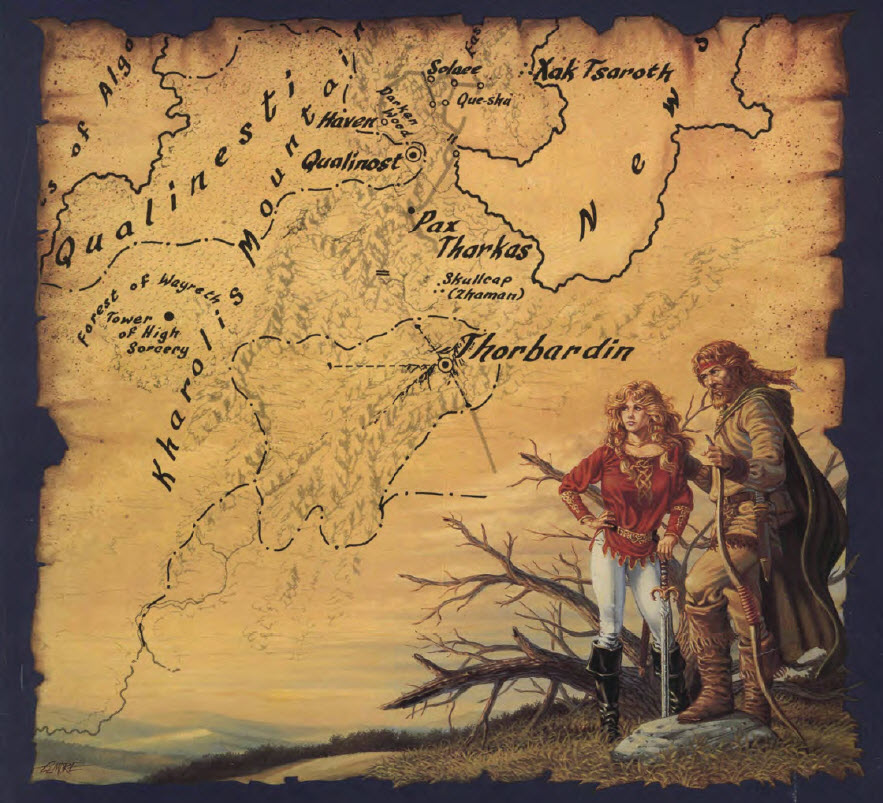
The Atlas of the Dragonlance World stands as an essential companion for anyone wanting to delve deeper into the epic saga of Krynn, the rich and intricate world of the Dragonlance setting in Dungeons & Dragons. Published to give both players and readers an intimate understanding of the lands they've come to love, this atlas provides a wealth of maps, geographical features, and insights into the diverse cultures and histories of the world. It's not merely a guidebook; it's an immersive journey that takes you from the towering peaks of the Kharolis Mountains to the treacherous reaches of Neraka.
Krynn, as depicted in the Dragonlance series, is a world filled with turmoil, ancient magic, and a pantheon of gods whose influence is felt throughout its realms. The atlas opens up this complex world by breaking down its many regions, cities, and notable landmarks. It does so with both a geographical perspective and a narrative flair, reminiscent of the epic novels that shaped the world.
One of the highlights of The Atlas of the Dragonlance World is how it provides context for the grand events of the series. For instance, fans of the Dragonlance Chronicles will remember the harrowing journey across the Blood Sea of Istar. The atlas captures this region's history, recounting the days when Istar was a city of light, guided by the Kingpriest. It details the Cataclysm that plunged the land into chaos, sinking Istar beneath the ocean's waves and creating the ominous Blood Sea Maelstrom. This geographical feature is not just a part of the world; it's a living testament to the fall of pride and the divine retribution that shaped Krynn's history.
The atlas also provides detailed maps of significant locations, such as the mystical city of Palanthas. Known for its towering Library of Palanthas and the imposing fortress of the High Clerist's Tower, this city is a hub of knowledge and power. The atlas gives a vivid portrayal of its layout, capturing the grandeur of its architecture and the importance of its strategic location on the Bay of Branchala. In addition, the maps allow readers to visualize the journeys undertaken by key characters in the novels, grounding their adventures in the physicality of Krynn's world.
Elven territories are another area that the atlas brings to life. The forests of Qualinesti and Silvanesti are not just described as wooded realms; they are portrayed as ancient homelands filled with both beauty and sorrow. Qualinesti, known for its vibrant tree city and egalitarian society, stands in stark contrast to the reclusive and proud Silvanesti, which was famously corrupted by a dark nightmare during the War of the Lance. The atlas details the geography of these forests, from the emerald canopy of Qualinesti to the crystal riverbanks of Silvanesti. It gives readers a sense of the elven struggle against the encroaching darkness and the tragic fall of their kingdoms.
A particularly fascinating section of the atlas dives into the desolation of Neraka, the dark heart of the Dragonarmies. Neraka is not simply a city; it is the epicenter of evil where Takhisis, the Queen of Darkness, sought to dominate Krynn. The atlas describes the jagged peaks that encircle the city, creating a natural fortress for the Dragonarmies. Its detailed rendering of the Temple of Takhisis - the seat of the Dark Queen's power - captures the foreboding atmosphere that pervades Neraka. For those familiar with the novels, it's easy to picture the grim march of the Dragonarmies as they set out from this place, spreading fear across the land.
A unique feature of the atlas is its attention to smaller, lesser-known locations. The dwarven kingdoms of Thorbardin, hidden beneath the Kharolis Mountains, are given special focus. The atlas details the intricate tunnels, the grand dwarven halls, and the lore surrounding the ancient conflict between the hill and mountain dwarves. This attention to detail allows readers to see beyond the epic battles and legendary figures, delving into the everyday lives and cultural nuances of Krynn's varied inhabitants.
For lovers of Dragonlance trivia, The Atlas of the Dragonlance World contains plenty of intriguing tidbits. It mentions the Icewall, a frozen wasteland inhabited by nomadic Ice Folk and dominated by the sinister Icewall Castle. The castle, made entirely of blue ice, was the home of the white dragon Highlord, Feal-Thas, and plays a crucial role in the Chronicles. Then there is the Tower of High Sorcery at Wayreth, a place shrouded in enchantment and secrecy. The atlas explains how the forest surrounding the tower shifts and moves, preventing all but the most determined or magically-inclined from finding it.
Interestingly, the atlas also touches on the mysterious island of Sancrist, home to the gnomes of Mount Nevermind. Gnomes in Krynn are renowned for their inventive, albeit often impractical, creations. The maps of Mount Nevermind show a sprawling network of tunnels, workshops, and laboratories, reflecting the gnomes' ceaseless drive for innovation. In a nod to Dragonlance lore, the atlas describes how the gnomes' inventions frequently go awry, yet their indomitable spirit remains a quirky and endearing aspect of Krynn's world.
Another notable aspect covered in the atlas is the Plains of Dust. This harsh, arid landscape was once a thriving region before the Cataclysm turned it into a desert. The Plains of Dust are home to the nomadic Plainsmen, who continue to eke out a living in this unforgiving environment. The atlas offers insights into their customs, their reliance on horses, and their reverence for nature - a stark contrast to the more urbanized cultures of Solamnia or the minotaur empire of Mithas.
The Atlas of the Dragonlance World serves as more than just a map collection; it is a narrative guide that breathes life into Krynn's many lands. It captures the diversity of the world, from the bustling marketplaces of Haven to the haunted ruins of Xak Tsaroth, where the goddess Mishakal first bestowed the Blue Crystal Staff upon the heroes. By exploring its pages, readers not only gain a sense of direction and geography but also an appreciation for the complex history and rich cultural that makes Dragonlance such an enduring part of fantasy literature.
This atlas is a celebration of the world of Krynn. It underscores the themes of heroism, loss, and the eternal struggle between good and evil that are central to the Dragonlance saga. Whether you are a player seeking to immerse your character in the world, a Dungeon Master crafting an adventure, or a reader nostalgic for the epic journeys of Tanis, Raistlin, and their companions, The Atlas of the Dragonlance World is a treasure trove of knowledge and lore. It invites you to step beyond the pages of the novels and into the very heart of the land, offering a path through every forest, mountain, and city that the heroes of Krynn once walked.
In memory of Karen Wynn Fonstad, let her words continue to guide us, so we may live to explore the worlds she brought to life.






